May bishops be shepherds, close to the people; fathers and brothers, may they be gentle, patient and merciful; may they love poverty, interior poverty, as freedom for the Lord, and exterior poverty.
John Bede Polding
Vicar Apostolic of New Holland 1834-1842; Archbishop of Sydney 1842-1877
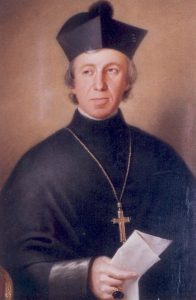 Born on 18 Nov 1794, Liverpool in England in the parish of Liverpool. (Liverpool Diocese)
Born on 18 Nov 1794, Liverpool in England in the parish of Liverpool. (Liverpool Diocese)
He was educated at Benedictine Convent Woolton, and Much (now Stanbrook, near Liverpool); Downside, and attended Seminary at Downside Abbey. He was ordained on 04 Mar 1819, Old Hall College by Bishop Poynter and incardinated in the Benedictines. He was elected as Bishop on 12 May 1834 as Titular Bishop of Hiero-Caesarea.
He was consecrated (ordained as Bishop) on 29 Jun 1834 in Golden Square London by Bishop Bramston (Consecrating Bishop) of the Diocese of Titular Bishop of Usula; Vicar Apostolic of London. He was assisted by Bishop Thomas Griffiths, the Titular Bishop of Olena, and Bishop Etienne Rouchouze, the Titular Bishop of Nilopolis, V. Ap. of Eastern Oceania.
He was subsequently translated (moved) as Bishop of Sydney 5 April 1842; Archbishop of Sydney 10 April 1842.
He retired on 10 January 1874, to Sacred Heart Presbytery, Darlinghurst.
He died on 16 Mar 1877, Sacred Heart Presbytery Darlinghurst, and is buried in Petersham Cemetery; exhumed 1946; re-interred in the Crypt St Mary’s Cathedral. “His remains were transferred to St Mary’s Cathedral 17 Mar 1901” (and were near the altar of Irish saints until 1946).
During his lifetime, he was Novice Master 1824; Secretary-General 0SB; Parish Priest Downside 1826. He was Titular Bishop of Hiero-Caesarea; Vicar Apostolic of New Holland and Van Diemen’s Land.
Roger Bede Vaughan
Archbishop 1877-1883
Born on 9 Jan 1834, Courtfield in Herefordshire England in the parish of Courtfield. (Newport & Menevia Diocese)
His father was John Francis Vaughan and his mother was Elizabeth Louise Rolls.
He was educated at Private Boarding School, Monmouth; Tuition at home because of ill-health; Benedictine School of St Gregory Downside, and attended Seminary at Downside Abbey; Rome.
He was ordained on 9 Apr 1859, St John Lateran Rome by Cardinal Patrizi VG and incardinated in the Order of St Benedict.
He was elected as Bishop on 5 Feb 1873 as Titular Archbishop of Nazianzan; Coadjutor Archbishop of Sydney. He was consecrated (ordained as Bishop) on 19 Mar 1873 in Liverpool England by Cardinal Henry E Manning (Consecrating Bishop) the Archbishop of Westminster. He was assisted by Bishop Robert Cornthwaite, the Bishop of Beverley, and Bishop James Chadwick, the Bishop of Hexham and Newcastle.
He subsequently succeeded as Archbishop of Sydney on 16 March 1877.
He died on 18 Aug 1883, Ince-Blundell, and is buried in Ince-Blundell; moved to St Michael’s Church Belmont; finally interred in the Crypt of St Mary’s, Cathedral, Sydney.
During his lifetime, he was Mission – attached to St Gregory’s Downside; Staff – St Michael’s House of Studies Belmont; Prior of the Diocesan Chapter, Newport and Menevia; Superior Belmont 1862-1873.
Patrick Francis Cardinal Moran
Cardinal Priest of Santa Susanna, 3rd Archbishop of Sydney (1884-1911)
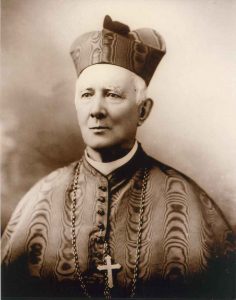 Cardinal MoranPatrick Francis Moran was born at Leiglinbridge, Ireland on 17 September 1830 to Patrick Moran and Alicia Cullen.
Cardinal MoranPatrick Francis Moran was born at Leiglinbridge, Ireland on 17 September 1830 to Patrick Moran and Alicia Cullen.
After attending the Irish College, Rome from age 12, he was ordained on 19 March 1853 in Rome by Archbishop Antonio Luigi-Bussi.
He served on the Staff of the Irish College, Rome as Vice-Rector from 1856.
He was Professor of Hebrew at Propaganda Fide College, Rome and the Private Secretary to Cardinal Paul Cullen, Dublin from 1866.
He was elected Bishop of Alba In Partibus Infidelium and coadjutor cum jure successionis of Ossory, Ireland, on 22 December 1871. Consecrated on 5 March 1872 by Cardinal Cullen at the Pro-Cathedral Dublin. Succeeded to Ossory on 11 August 1872.
Promoted to the Archdiocese of Sydney on 14 March 1884.
Created Cardinal Priest on 27 July 1885 of the title of St Susanna.
Cardinal Moran was a prolific writer of histories, including Persecutions of Irish Catholics, Church and Social Progress, History of the Catholic Church in Australasia, Reunion of Christendom, Capital and Labour, Mission of the Catholic Church, The Anglican Reformation, Catholics and Irishmen among many others.
Cardinal Moran died on 15 August 1911.
Archbishop Michael Kelly
4th Archbishop of Sydney (1911-40)
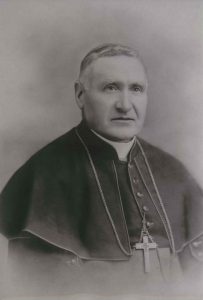 Michael Kelly was born at Waterford, Ireland, on 13 February 1850 to James Kelly and Mary Grant.
Michael Kelly was born at Waterford, Ireland, on 13 February 1850 to James Kelly and Mary Grant.
He was educated at Christian Brothers’, Enniscorthy and the Classical Academy, New Ross.
He received his seminary formation at St Peter’s College, Wexford and the Irish College, Rome.
He was ordained on 1 November 1872 by Bishop Thomas Furlong at Enniscorthy.
He served on the staff of the House of Missions, Wexford and was Rector of the Irish College, Rome.
Elected Archbishop of Achrida In Partibus Infidelium and coadjutor cum jure successionis of Sydney on 20 July 1901, Consecrated Coadjutor Archbishop on 15 August 1901 at St Joachim’s Church, Rome, by Cardinal Francesco Satolli.
He succeeded to the See on 16 August 1911 on the death of Cardinal Moran.
He was named Bishop Assistant at the Papal Throne and Count of the Holy Roman Empire on 25 June 1926.
Archbishop Kelly died on 8 March 1940.
Sir Norman Thomas Cardinal Gilroy KBE
Cardinal Priest of the Four Crowned Martyrs, 5th Archbishop of Sydney (1940-71)
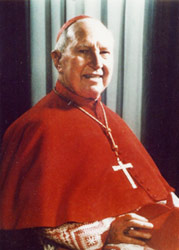 Norman Thomas Gilroy was born in Sydney on 22 January 1896 to William James Gilroy and Catherine Slattery. He was educated at St Benedict’s School Broadway, and Marist Brothers’ College, Kogarah.
Norman Thomas Gilroy was born in Sydney on 22 January 1896 to William James Gilroy and Catherine Slattery. He was educated at St Benedict’s School Broadway, and Marist Brothers’ College, Kogarah.
He was a veteran of the Gallipoli campaign of 1915.
He attended Seminary at St Columba’s Springwood, and Propaganda Fide, in Rome. He was ordained a priest on 24 December 1923 at St John Lateran Basilica, Rome, by Cardinal Van Rossom.
He served as the Secretary to the Apostolic Delegation, 1924 and Chancellor and Diocesan Secretary for Lismore Diocese, 1931.
Elected Bishop of Port Augusta on 10 December 1934 and consecrated on 17 March 1935 at St Mary’s Cathedral, by Archbishop Philip Bernadini.
Promoted Archbishop of Cypsela In Partibus Infidelium and coadjutor cum jure successionis of Sydney on 1 July 1937. Succeeded to the Archdiocese of Sydney on 8 March 1940.
Created Cardinal on 18 February 1946, the first Australian-born member of the Sacred College.
Created Knight Commander of the British Empire 1969, the first Cardinal to be knighted since the Reformation, and he was Australian of the Year in 1970.
Resigned as Archbishop on 9 July 1971.
Cardinal Gilroy died on 21 October 1977.
James Darcy Cardinal Freeman KBE
Cardinal Priest of Our Lady Queen of Peace at Ostia, 6th Archbishop of Sydney (1971-83)
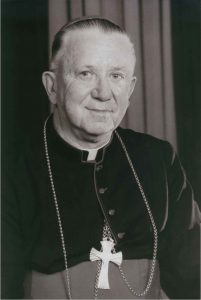 James Darcy Freeman was born in Sydney 19 November 1907 to Robert Freeman and Margaret Smith.
James Darcy Freeman was born in Sydney 19 November 1907 to Robert Freeman and Margaret Smith.
He was educated at the Sisters of Charity, Elizabeth Bay, and Christian Brothers’ School, St Mary’s Cathedral, Sydney. He attended Seminary at St Columba’s, Springwood and St Patrick’s, Manly.
He was ordained on 13 July 1930 by Archbishop Bartolomeo Cattaneo. He served as an Assistant Priest at Grafton & Murwillumbah (Lismore Diocese); Strathfield, Mosman and St Mary’s Cathedral.
He was the Private Secretary to the Cardinal Archbishop, and Chaplain to the Christian Brothers’, Strathfield. He also served as Administrator of Haymarket Parish, and Parish Priest of Stanmore.
Elected Bishop of Hermopolis In Partibus Infidelium and auxiliary of Sydney on 9 December 1956. He was consecrated on 24 January 1957 at St Mary’s Cathedral, Sydney by Cardinal Gilroy. Translated to Armidale as Bishop 18 October 1969. He was promoted to Archbishop of Sydney on 9 July 1971.
He was made Cardinal Priest of the Title of Our Lady Queen of Peace of Ostia on 5 March 1973.
Created Knight Commander of the British Empire 1977.
Resigned on 12 February 1983.
Cardinal Freeman died on 16 March 1991.
Edward Bede Cardinal Clancy AC
Cardinal Priest of Santa Maria in Vallicella, 7th Archbishop of Sydney (1983-2001)
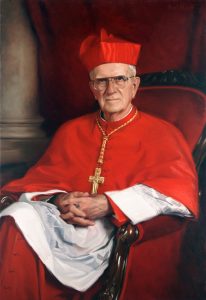 Edward Bede Clancy was born in Lithgow on 13 December 1923, the son of John Bede Clancy and Ellen Lucy Edwards. He was educated at Holy Camp Public School (Grenfell), St Monica’s Primary School and Good Samaritan School, Richmond and Marist Brothers’ College, Parramatta.
Edward Bede Clancy was born in Lithgow on 13 December 1923, the son of John Bede Clancy and Ellen Lucy Edwards. He was educated at Holy Camp Public School (Grenfell), St Monica’s Primary School and Good Samaritan School, Richmond and Marist Brothers’ College, Parramatta.
After studying for the priesthood at St Columba’s College, Springwood, and St Patrick’s College, Manly, he was ordained a priest in St Mary’s Cathedral, Sydney, by Cardinal Sir Norman Gilroy, then Archbishop of Sydney, on 23 July 1949. His first appointment was as assistant priest in Belmore in December 1949.
Sent to study in Rome in 1951, Fr Clancy graduated with a Licentiate in Theology (STL) from the Angelicum University and a Licentiate of Sacred Scripture (LSS) from the Pontifical Biblical Institute. Returning in 1955, he served as assistant priest at the parishes of Elizabeth Bay and Liverpool before taking up his appointment as Professor of Sacred Scripture at St Columba’s College, Springwood in February 1958.
In 1961, he went abroad for further studies, obtaining his Doctorate in Sacred Theology in 1965. On his return, he was appointed Chaplain at Sydney University and the Catholic Centre. He then joined the professorial staff at St Patrick’s College, Manly teaching Sacred Scripture in the Faculty of Theology. He was also involved in pastoral work, particularly in giving conferences and spiritual retreats to priests and members of religious orders.
He was still at Manly when, on 15 November 1973, Pope Paul VI appointed him Titular Bishop of Ard Carna and auxiliary to Cardinal Freeman. His Episcopal Ordination took place in St Mary’s Cathedral on 19 January 1974. He took charge of the outer western region, with headquarters at Blacktown, where he was also parish priest. At this time he was well known to the media as official spokesperson for the Archdiocese and also for the Australian Bishops’ Conference.
On 24 November 1978, Pope John Paul II appointed Bishop Clancy to the Archdiocese of Canberra and Goulburn. A little over four years later, on 22 February 1983, Pope John Paul II announced Archbishop Clancy’s appointment as seventh Archbishop of Sydney, in succession to retiring Cardinal Sir James Freeman.
His reception and installation as Archbishop of Sydney took place in St Mary’s Cathedral on 27 April 1983. Cardinal Clancy was made a Member of the Order of Australia (OAM) on 1 January 1984 and Officer of the Order of Australia (AC) in 1992.
He was elevated to the Sacred College of Cardinals and received his red biretta, the traditional sign of his office, from Pope John Paul II at a Vatican consistory in Rome on 28 June 1988. His responsibilities have included being a member of the Council of Cardinals and Bishops; President of the Australian Bishops Conference, 1986-2000; Chancellor of Australian Catholic University, 1991. He was a member of the Congregation for Bishops; the Pontifical Commission for Pastoral Care for Health Workers; the Council of Synod of Bishops, Pontifical Commission for Social Communication; and the Council of Cardinals for the study of economic problems of the Holy See.
Other achievements include the renovation and completion of St Mary’s Cathedral with the construction of the two spires and the overseeing of the transition from St Patrick’s College, Manly to the new Seminary of the Good Shepherd, Homebush.
On 26 March 2001 Cardinal Clancy’s resignation was accepted by Pope John Paul II, having exceeded the age limit of 75 years, with his retirement from office taking effect on 10 May 2001.
During his retirement, Cardinal Clancy wrote Come Back! – an appeal to lapsed Catholics to return to church practice.
Cardinal Edward Clancy’s Crest: On the left hand side of the shield are the established arms of the Archdiocese of Sydney – the Southern Cross. On the right hand side are his own personal arms. The lions are taken from the crest of the Clancy family, and the circle and book represent the Host and the open Bible – symbolising the Word of Scripture and the Word of the Eucharist. The motto “Fides Mundum Vincit” translated from the Latin means “Faith conquers the World.” (1 John 5, 4 )
The ideas were the Cardinal’s own and were provided to a professional who presented them in their present form.
George Cardinal Pell
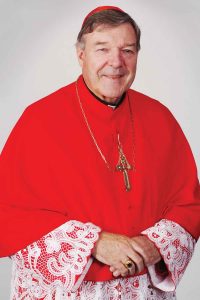 Cardinal George Pell was born in Ballarat, on June 8th 1941, and was educated in that city at Loreto Convent and St Patrick’s College. He studied for the priesthood at Corpus Christi College, Werribee, and Propaganda Fide College, Rome, and was ordained a Catholic priest for the Diocese of Ballarat by Cardinal Agagianian in St Peter’s Basilica, Rome, on December 16th 1966.
Cardinal George Pell was born in Ballarat, on June 8th 1941, and was educated in that city at Loreto Convent and St Patrick’s College. He studied for the priesthood at Corpus Christi College, Werribee, and Propaganda Fide College, Rome, and was ordained a Catholic priest for the Diocese of Ballarat by Cardinal Agagianian in St Peter’s Basilica, Rome, on December 16th 1966.
On May 21st 1987 he was ordained an Auxiliary Bishop of the Archdiocese of Melbourne and Titular Bishop of Scala by Archbishop Sir Frank Little in St Patrick’s Cathedral.
On July 16th 1996 Pope Saint John Paul II announced Cardinal Pell’s appointment as seventh Metropolitan Archbishop of Melbourne. He was installed as Archbishop on August 16th 1996 in a ceremony at the Exhibition Buildings, and received the Pallium from the Pope at St Peter’s in Rome on the feast of Sts Peter and Paul, June 29th 1997.
On March 26th 2001 Pope John Paul II appointed Cardinal Pell the eighth Metropolitan Archbishop of Sydney. He was installed as Archbishop at St Mary’s Cathedral on May 10th 2001, and the following month received the Pallium from the Pope for the second time at St Peter’s in Rome on the feast of Sts Peter and Paul. His elevation to the Sacred College of Cardinals was announced by the John Paul II on September 28th 2003, who created him Cardinal Priest of the Church of Saint Maria Domenica Mazzarello in Rome.
On February 24th 2014, the Holy Father Pope Francis appointed Cardinal Pell Prefect of the newly-created Secretariat for the Economy at the Vatican.
Cardinal Pell holds a Licentiate in Theology from Urban University, Rome (1967), a Masters Degree in Education from Monash University, Melbourne (1982), and a Doctorate of Philosophy in Church History from the University of Oxford (1971). He is a Fellow of the Australian College of Educators, and was Visiting Scholar at Campion Hall, Oxford University, in 1979 and at St Edmund’s College, Cambridge University, in 1983. He was elected an Honorary Fellow of St Edmund’s in 2003.
Before becoming Archbishop of Melbourne Cardinal Pell worked as Assistant Priest in the parishes of Swan Hill (1971-2) and Ballarat East (1973-83), as Administrator of Bungaree parish (1984) and as Parish Priest of Mentone and Bishop for the Southern Region of Melbourne (1987-96).
Cardinal Pell served as Director of the Aquinas Campus of the Institute of Catholic Education from 1974 to 1984 and as Principal of the Institute of Catholic Education (now merged into Australian Catholic University) from 1981 to 1984. He was Episcopal Vicar for Education in the Diocese of Ballarat (1973-84), a founding member of the Catholic Education Commission of Victoria (1973-84), a member of the Academic Board of the State College of Victoria and at different times a member of the Councils of the State College of Victoria – Ballarat, the Ballarat College of Advanced Education, and Signadou College Canberra.
From 1988 to 1997 Cardinal Pell was a member of the National Catholic Education Commission. He was a member of the Bishops’ Committee for Education from 1994 to 1997 (as Secretary) and again from 2000 to 2006 (as Chairman from 2003). In 1989 Cardinal Pell was appointed Chairman of the committee charged with setting up the new Australian Catholic University, and in 1991 to 1995 he served as the University’s Foundation Pro-Chancellor. In 1999 to 2000 he assisted in the establishment of the new city campus of the University in Melbourne. Cardinal Pell was President of the University’s board of owners from1996-2014.
Cardinal Pell’s commitment to Catholic tertiary education is also reflected in the role he played in establishing campuses of the University of Notre Dame Australia in Sydney, giving the east coast of Australia its first Catholic law school and first Catholic medical school. In 2003 he served as Patron of the capital appeal for Campion College, Australia’s first Catholic liberal arts college.
Christendom College, an American Catholic liberal arts institution based in Virginia, conferred the degree of Doctor of Humane Letters (honoris causa) on Cardinal Pell in 2006, and in 2008 Thomas Aquinas College in California awarded Cardinal Pell the Saint Thomas Aquinas Medallion for his service to the mission and teachings of the Church. The University of Notre Dame Australia conferred the honorary degree of Doctor of Laws on Cardinal Pell in 2010, in recognition of the role he played in establishing campuses of the University in Sydney. In 2014 Australian Catholic University conferred on Cardinal Pell the honorary degree of Doctor of Laws, in recognition of his outstanding contribution to the Church in Australia and his appointment as Prefect of the Secretariat for the Economy.
From 1985 to 1987 Cardinal Pell was Rector of Corpus Christi College, the Provincial Seminary for Victoria and Tasmania. In 1990 Pope John Paul II nominated the then Bishop Pell to the Synod of Bishops in Rome on the preparation of priests, where he served as one of the Synod spokesmen and on the Committee which prepared the final Synod Message. He was appointed Apostolic Visitor to the National Seminaries of New Zealand (1994), Papua New Guinea and the Solomon Islands (1995), the Pacific (1996) and Irian Jaya and Sulawesi (1998) by the Congregation for the Evangelization of Peoples in the Vatican. In 1999, as Archbishop of Melbourne, Cardinal Pell established new facilities for both Corpus Christi College in Carlton and Catholic Theological College in East Melbourne.
Cardinal Pell was Chairman of Caritas Australia, the Catholic Church’s Australian agency for overseas development and relief, from 1988 to 1997. He was a member of the Bishops’ Committee for Justice Development and Peace from 1987 to 1997 and has been a member of the Pontifical Council for Justice and Peace from 1990 to 1995 and again from 2002. From 1990 to 2000 he was a member of the Vatican Congregation for the Doctrine of the Faith, and has been Chairman of the Australian Catholic Bishops’ Commission for Doctrine and Morals since 2001.
Having served as a Consultor to the Pontifical Council for the Family for many years, Cardinal Pell was appointed to the Presidential Committee of the Council in 2002. In 2005 he was appointed a member of the Supreme Committee of the Pontifical Missions Societies by the Congregation for the Evangelization of Peoples.
In November 1998 Cardinal Pell attended the Synod for Oceania in Rome. He was appointed by Pope John Paul II to represent the Bishops of Australia and Oceania at the Special Synod for European Bishops in Rome in 1999, and at the Synod of Bishops held in October 2001. Pope Benedict XVI also appointed Cardinal Pell to the Synod of Bishops held in October 2006 to mark the close of the Year of the Eucharist, and to the October 2012 Synod on the New Evangelisation. From 2001 to 2008 he served successive terms on the Council of the Synod of Bishops, and again from 2012. In 2008 Pope Benedict appointed Cardinal Pell one of three President-Delegates of the Synod on the Word of God in the Life and Mission of the Church.
In April 2002 Cardinal Pell was named President of the Vox Clara Committee to advise the Congregation for Divine Worship on English translations of liturgical texts. He was appointed a member of the Congregation for Divine Worship in January 2005.
From 2007-14 Cardinal Pell served on the Council of Cardinals on Organisational and Economic Problems of the Holy See. In 2008 he was appointed to the Governing Committee of the International Catholic Migration Commission, which oversees relief work in support of migrants, refugees and displaced persons on behalf of the Holy See. In December 2010 Pope Benedict XVI appointed Cardinal Pell a member of both the newly-established Pontifical Council for Promoting the New Evangelisation, and the Pontifical Council for Pastoral Assistance to Health Care Workers. He was appointed to the Congregation for Bishops in September 2012.
In April 2005 Cardinal Pell took part in the Conclave of 115 Cardinal Electors which elected His Holiness Pope Benedict XVI as the successor to Pope Saint John Paul II; and in March 2013 Cardinal Pell was a member of the Conclave of 115 Cardinal Electors who elected His Holiness Pope Francis to succeed Pope Benedict XVI.
In April 2013 Cardinal Pell was appointed by Pope Francis to a group of eight cardinals to advise the Holy Father on the government of the universal Church and to study a plan for revising the Apostolic Constitution on the Roman Curia, Pastor Bonus.
In February 1998 Cardinal Pell attended the Constitutional Convention in Canberra as a delegate appointed by the Prime Minister. He served on the Resolutions Committee responsible for drafting motions put to the Convention and moved the motion in support of the Republican model which was finally adopted by the Convention. On March 21st 2001 he addressed a joint sitting of the Victorian Parliament on the drug problem.
Cardinal Pell was awarded the Centenary Medal by the Australian Government on April 21st 2003, in recognition of his service to the Australian community through the Catholic Church. He was made a Companion in the Order of Australia in the Queen’s Birthday Honours in 2005 for service to the Catholic Church in Australia and internationally, to raising debate on matters of an ethical and spiritual nature, to education, and to social justice. In November 2011 Cardinal Pell was awarded the Medal of Gratitude by the Republic of Poland, in recognition of his support for the Solidarity trade union movement when Poland was under Communist rule.
Cardinal Pell was Grand Prior of the Equestrian Order of the Holy Sepulchre of Jerusalem, Australian Lieutenancy – Southern, from 1998 to 2001, and Grand-Prior of the Order in New South Wales from 2001-14. Cardinal Pell was created Knight Grand Cross of the Order in 2003 to mark his elevation to the Sacred College of Cardinals.
Cardinal Pell’s long-standing commitment to ecumenism was recognized in 1998 with the conferral of the Grand Cross of Merit of the Order of Saint Lazarus, and his promotion to Ecclesiastic Grand Cross of St Lazarus, the Order’s highest ecclesiastical rank, in 2003. From 2001 to 2007 he served as the Order’s National Chaplain.
In 2007 Cardinal Pell was appointed Conventual Chaplain ad honorem of the Sovereign Military Order of Malta. In 2008 he was invested Bailiff Grand Cross of Honour and Devotion in the Order of Malta.
Cardinal Pell became a member of the Sacred Military Constantinian Order of St George in February 2011, being invested Bailiff Grand Cross of Justice in a ceremony at the Oratory Church in London.
Cardinal Pell’s work in inter-faith relations has included attendance at the Asia-Pacific Interfaith Dialogue (originally established as the Australian-Indonesian summit on inter-religious dialogue and terrorism) in 2004, 2006 and 2007. On each occasion, he attended the Dialogue as part of the official Australian delegation led by the Minister for Foreign Affairs.
In 2008, as part of his commitment to encouraging the practice of religious pilgrimage and to supporting pilgrims, Cardinal Pell led a group Australian dioceses in acquiring a building for an Australian pilgrim centre in Rome. Named Domus Australia, the centre was officially opened by Pope Benedict XVI on 19 October 2011, in the presence of the bishops of Australia gathered in Rome for their ad limina apostolorum pilgrimage.
Cardinal Pell as Archbishop both in Melbourne and Sydney has been involved in leading pilgrimages of young Australians to World Youth Days in Rome, Toronto, Cologne and Madrid. Following the Toronto World Youth Day the Archdiocese of Sydney examined the possibility of hosting the event, placing a formal bid for this honour with the Holy See in 2005. The success of this bid was announced at the conclusion of World Youth Day in Cologne in August 2005. The twenty-third World Youth Day was held in Sydney from 15-20 July 2008, forming the largest gathering in Australia’s history. Over 110,000 registered pilgrims from more than 170 nations, including Pope Benedict XVI, travelled to Sydney for the occasion, together with another 123,000 registered pilgrims from Australia. 26 Cardinals, 420 Bishops, and 4,000 priests were also in attendance. Cardinal Pell celebrated the Opening Mass at Barangaroo on Sydney Harbour before 150,000 pilgrims on 15 July. At the Papal Arrival, 500,000 people welcomed Pope Benedict on his first visit to Australia, and the final Mass at Randwick Racecourse, which was celebrated by the Holy Father on 20 July, attracted over 400,000 people.
Cardinal Pell’s interest in and support for young people, marriage and families has been demonstrated not only in his preaching and many public statements on these matters, but also in his involvement in founding the Australian campus of the international John Paul II Institute for Marriage and the Family; the institution of Australia’s first independent commissioner to handle sexual abuse complaints against clergy; and in the creation of the Mary of the Cross Centre in Melbourne to assist families with a member affected by drug or alcohol abuse. As Archbishop of Melbourne he commissioned the production of To Know, Worship and Love, a series of texts for use in religious education in Catholic schools. The series continues to be used in the Archdiocese of Melbourne, and was officially launched and mandated for use in the schools of the Archdiocese of Sydney at the end of 2003.
As Archbishop in Melbourne and Sydney Cardinal Pell established Life Offices to promote deeper respect for human life from conception until natural death. In 2003 he inaugurated a competitive bi-annual grant from the Archdiocese of Sydney to support medical research into the development and application of treatments using adult stem cells. In 2008 Cardinal Pell’s work in defending the dignity of human life was recognised with the conferral of the US$100,000 Mysterium Vitae Award by the Archdiocese of Seoul in South Korea.
Cardinal Pell has written widely in religious and secular magazines, learned journals and newspapers in Australia and overseas, and regularly speaks on television and radio. He was editor of Light, the magazine of the Ballarat diocese from 1979 to 1984, and from 2001-14 he was a weekly columnist for Sydney’s Sunday Telegraph. Cardinal Pell is a well-known public speaker, who has lectured in the United States of America, England, Ireland, New Zealand, Croatia, Canada and Korea, and every State of Australia.
In September 1996 Oxford University Press published Issues of Faith and Morals, written by Cardinal Pell for senior secondary classes and parish groups. Other publications include The Sisters of St Joseph in Swan Hill 1922-72 (1972), Catholicism in Australia (1988), Rerum Novarum: One Hundred Years Later (1992), Issues of Faith and Morals (OUP, 1996), Catholicism and the Architecture of Freedom (1999), Be Not Afraid (2004), God and Caesar: Selected Essays on Religion, Politics and Society (2007), Free for All: Negotiating Freedom in a World of Individuals (2009), Test Everything: Hold Fast to What is Good (2010), and One Christian Perspective on Climate Change (2011). Cardinal Pell’s most recent publication is Contemplating Christ with Luke, a book of homilies on St Luke’s Gospel, published by Connor Court in 2012.
In earlier years Cardinal Pell was a keen sports coach in soccer, Aussie Rules and rowing. He is Vice Patron of the Richmond Football Club and a long term supporter and member of the Club since he signed to play with them in 1959.
A popular biography of Cardinal Pell by senior journalist Tess Livingstone was published by Duffy and Snellgrove in 2002, and an expanded American edition of this biography was released by Ignatius Press in 2004.


